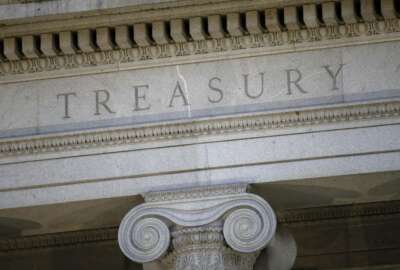
Treasury’s Fiscal Service setting pace for federal financial management transformation
The Treasury Department’s Bureau of the Fiscal Service is looking to modernize the way the federal government does business — and giving agencies a status...
The Treasury Department’s Bureau of the Fiscal Service is looking to modernize the way the federal government does business — and giving agencies a status update on its goals through the end of the decade.
Fiscal Service recently gave agency chief financial officers an update on progress made toward its financial management goals in fiscal 2022.
Among the highlights, the bureau launched a governmentwide marketplace for agencies to seek financial management services. The bureau also exceeded its cost savings goal by having more agencies adopt shared financial management systems.
Commissioner Tim Gribben said that the bureau, by connecting agencies with shared services providers, is able to help agencies “focus on their core missions, rather than more technical details around providing the services.”
“I look to the bureau to help set that pace for the federal government. That’s why when we look at the vision, we translate it into actionable goals,” Gribben said in a recent interview.
The bureau in December 2022 launched the financial management Quality Services Management Office (QSMO).
The QSMO serves as a one-stop-shop for agencies to connect with three federal shared service providers — Treasury’s Administrative Resource Center, the Interior Business Center and the Transportation Department’s Enterprise Service Center.
It also serves as a hub for agencies to track down financial services offered by commercial providers. Three vendors are currently offering their services on the marketplace — CGI Federal, HIC International and eMentum.
Gribben said additional vendors are going through the onboarding process to be added to the QSMO marketplace, and that the bureau is reaching out to additional vendors to offer their products on the financial management QSMO.
Gribben said the bureau is also reaching out to agencies to make them aware of services available on the QSMO that will help them upgrade or maintain their core financial systems.
“It’s helping us focus our understanding of the agency needs, as we’re providing the marketplace solutions,” Gribben said. “It’s one thing to have the marketplace, it’s how do you get people to use it.”
The Trump administration launched QSMOs in April 2019 in an effort to centralize mission support capabilities across the federal government. Other agencies oversee QSMOs for cybersecurity, human resources and grants management.
Cost savings from shared services
Through a governmentwide increase in the use of shared financial management systems, the bureau estimates agencies saved more than $600 million in 2022.
Gribben said the bureau calculates the cost savings by estimating what agencies would spend if they each ran their own financial system, procurement travel systems.
“When you are able to centralize that, you achieve cost savings,” he said. “Rather than spending money on licensing [and] system development, they spend it on their core mission instead. So they can translate that into delivering more for their customer, by using a shared service.”
The bureau is also focused on improving customer experience for other federal agencies, the public and the bureau’s own employees. The bureau launched a customer experience office last fall.
“Employees are also users of our service as well,” Gribben said. “We really look at customers from all three perspectives, and that can be challenging, which is why we created the office so that we can focus on those things.”
Gribben said the bureau, as part of this customer experience overhaul, is working to understand the root cause of some negative customer experiences. Record demand for Treasury-issued I savings bonds, for example, “led to an unprecedented volume of calls to our call center that we were not set up for.”
“We learned a lot about why people were calling into the call center and creating solutions to address those needs,” he said.
In response, Fiscal Service now offers more self-service options, including when customers need to reset a password or change the bank account linked to their account. Gribben said customers previously could only make these changes over the phone.
Getting payments right
The bureau, in light of agencies investigating fraud, waste and abuse from COVID-19 spending programs, is also taking steps to stop improper payments from being issued.
Gribben said the bureau is bringing its Payment Integrity Center of Excellence and Do Not Pay under one roof as part of the Office of Payment Integrity.
“We’re envisioning what does that future of payment integrity look like, and how do we interact with agencies to provide the services that they need, as well as the states who are administering federally funded programs,” Gribben said.
Gribben said the bureau launched a pilot of an account verification tool, that has since been scaled up to be its own program.
“We can have more confidence that when we’re getting an instruction to pay somebody through a particular bank account, we can verify that truly is a bank account that’s owned and controlled by that individual,” he said.
The bureau is also looking to G-Invoicing to strengthen financial accuracy across government. The program manages intragovernmental buy-and-sell transactions through a web-based platform.
“There was no authoritative source of those financial transactions, and so they were not being eliminated properly,” Gribben said. “When I was the CFO at the Small Business Administration, it used to drive me crazy that we would use other agencies, like [General Services Administration (GSA)] and the Department of Interior, but we accounted for those intergovernmental transactions differently. It caused a difference, because I had one way of accounting for it, and they had another way of accounting for it.”
Gribben said the agencies are not on track to meet its FY 2023 goal for G-invoicing, but said significant progress has been made, more broadly, on reducing intergovernmental differences.
While there were more than $1 trillion in intergovernmental differences in fiscal 2017, that estimate shrank to $45 billion in FY 2022. Gribben said buy/sell transactions make up $13.7 billion of that $45 billion figure.
“There’s a lot more work to do on G-invoicing. But by continuing to publish it, it highlights the work that we need to do, and the value that it’s obtained by having a common solution that agencies will use,” Gribben said.
Copyright © 2025 Federal News Network. All rights reserved. This website is not intended for users located within the European Economic Area.
Jory Heckman is a reporter at Federal News Network covering U.S. Postal Service, IRS, big data and technology issues.
Follow @jheckmanWFED
Related Stories




